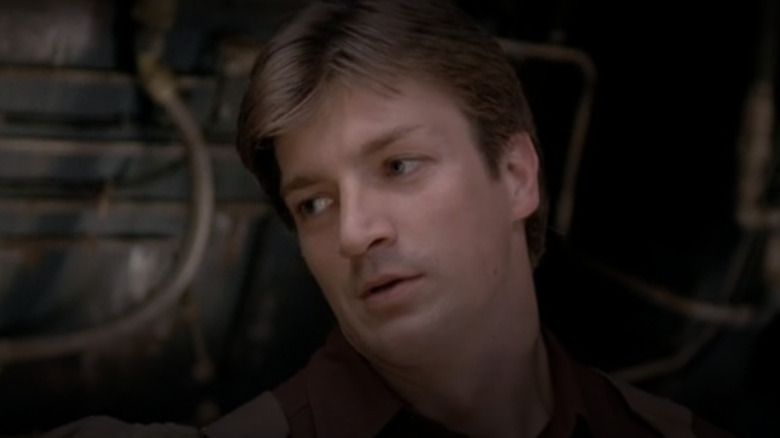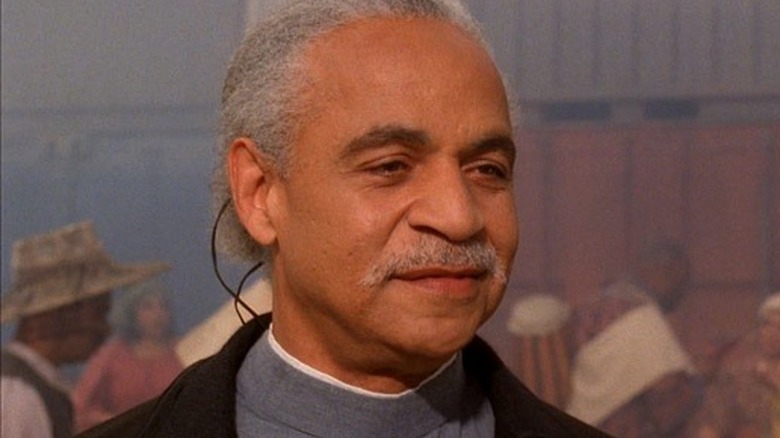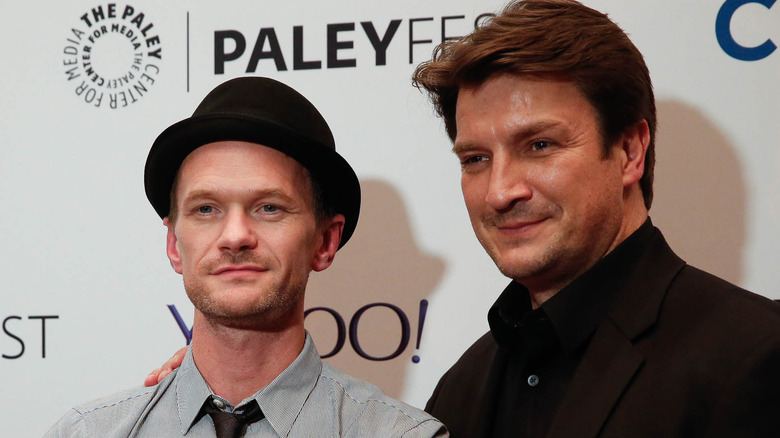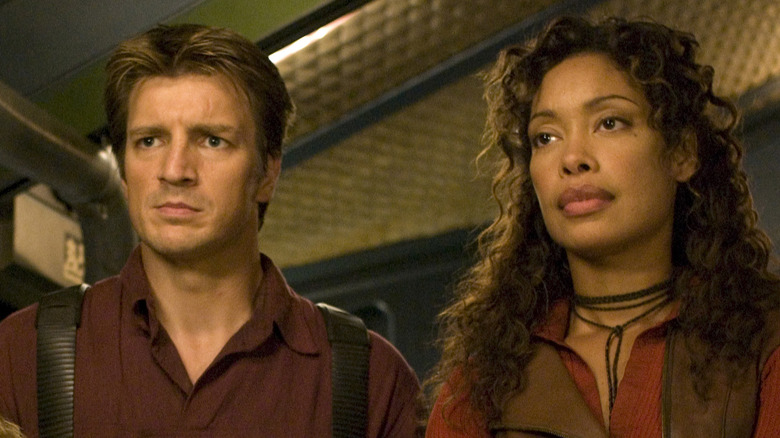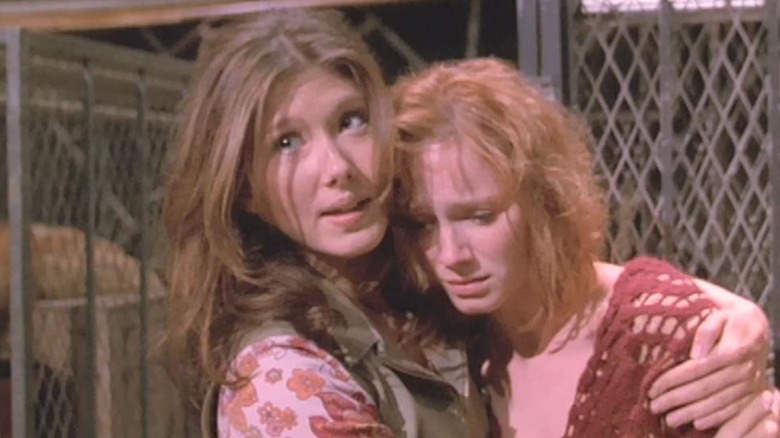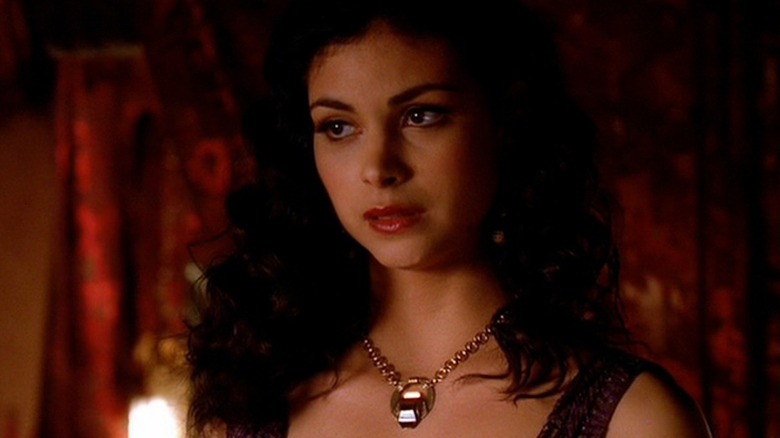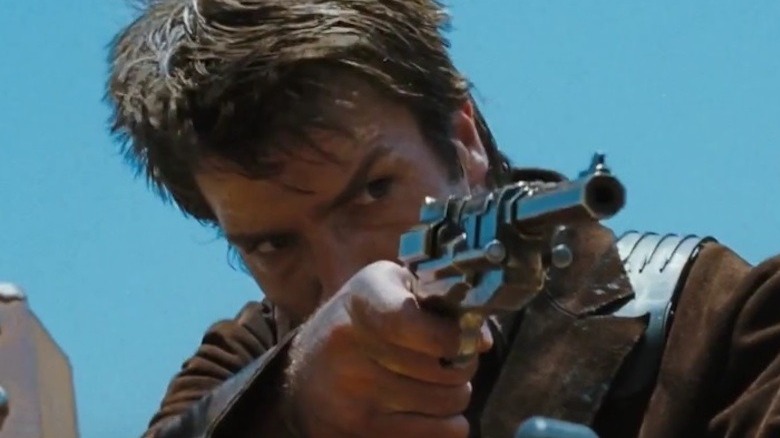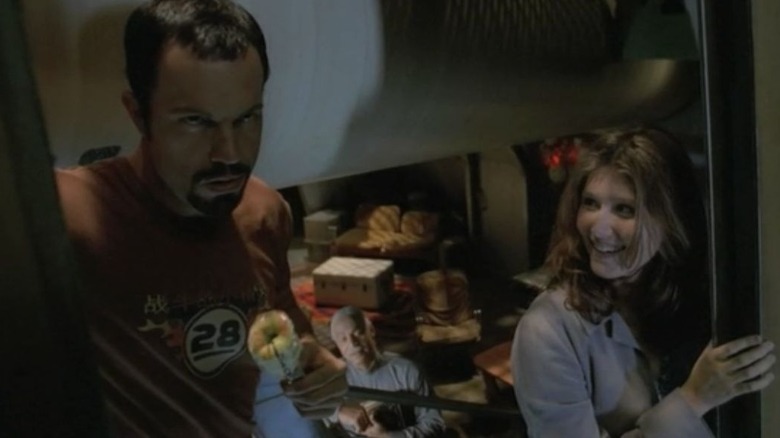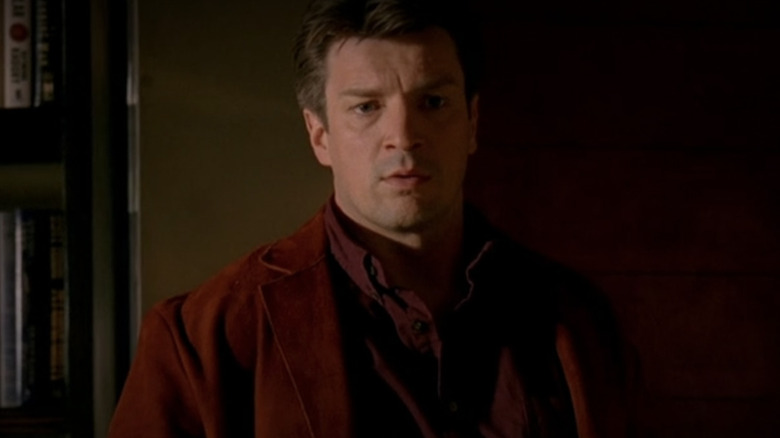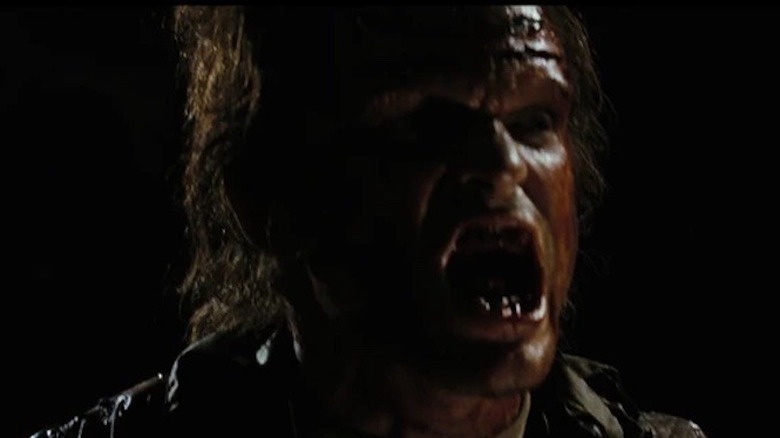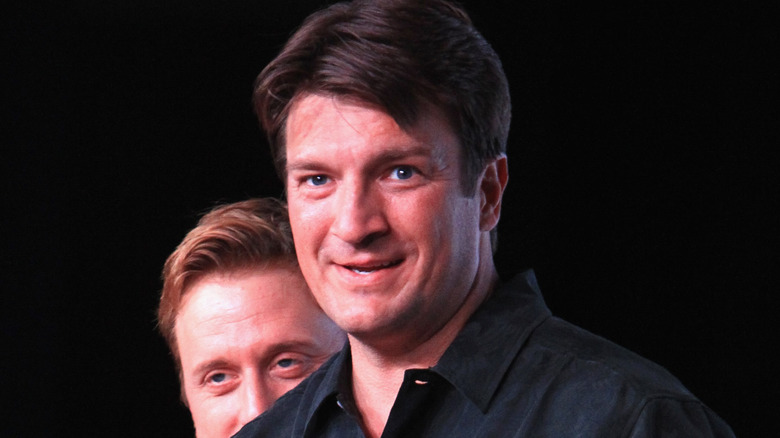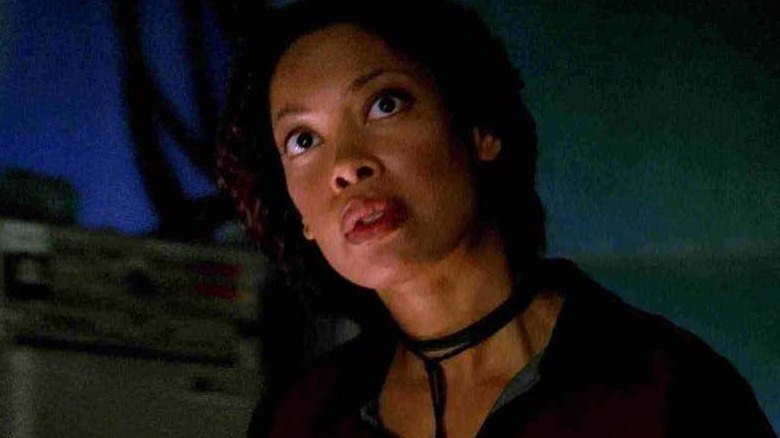The Untold Truth Of Firefly
"Firefly" is one of the all-time greatest space shows, but it's also one of the most well-realized Westerns in TV history. But then, it's also a little bit of a comedy, and a little bit of a soap opera. "Firefly" is heavy on drama and social commentary, as well as pretty to look at, and it would turn out to be a star-making vehicle for the likes of stars Nathan Fillion (Captain Mal Reynolds) and other TV stalwarts (Alan Tudyk, Gina Torres, Summer Glau.) Together, they would portray a group of "Browncoats" and miscreants traveling to distant planets in a compact spaceship in 2517, smuggling and saving the misbegotten along the way.
Created by "Buffy the Vampire Slayer" and "Angel" showrunner Joss Whedon, "Firefly" is a rich and dense show with a deep mythology out of the gate and one of the best ensembles ever assembled. It is arguably the ultimate cult classic, pulled from the air after half a season, only to later build an audience and wrap up with the feature film "Serenity." Now go on and git, right into the 'Verse and have an all-fired bang-up time on this here peck of waves. (In other words, some behind-the-scenes stories you may not have known about "Firefly.")
Firefly is really a Western
"Firefly" is a science-fiction show, concerning the space-set adventures of a band of rogues, but it just as much keeps alive the tropes of Westerns. According to "Joss Whedon: The Biography" by Amy Pascale (via Gizmodo), the nugget of what would become "Firefly" came to creator Joss Whedon during a vacation to London. To read on the trip, he brought along Michael Shaara's 1974 Pulitzer Prize-winning "The Killer Angels," a historical novel about the hardscrabble lives of soldiers fighting in the Civil War's Battle of Gettysburg in 1863. As part of a deal with the Fox network, he had to submit a new show soon, and the book inspired him.
"I wanted to play with that classic notion of the frontier. Not the people who made history, but the people history stepped on," Whedon said, adding that he wanted to explore "how politics affect people personally" while also pulling from 1970s movie Westerns, "the ones about 'this is all we have out here, so we might be dead soon.'" But Whedon also wanted to make a show set in space, offering "gritty realism that wasn't an 'Alien' ripoff," and which didn't look "cheesy" like so many other made-for-TV sci-fi projects.
Whedon mashed all that together and it became "Firefly," the final touch coming when he expanded the character list from just a handful to a full cast of nine — just like in John Ford's classic 1939 Western "Stagecoach," which followed seven strangers as they traversed the American frontier.
Firefly could have had a much different cast
After supporting roles in "Saving Private Ryan" and "Blast from the Past," and a big part in the '90s ABC sitcom "Two Guys, a Girl, and a Pizza Place," Nathan Fillion became a pop culture icon because of his time on "Firefly." He's so intertwined with the role of Captain Mal Reynolds for so many people that it's something of a surprise that the part was written with another actor in mind.
At a 2014 Comic-Con, according to a Redditor's account, Nicholas Brendon, best known as Xander on "Buffy the Vampire Slayer," said that his boss, creator Joss Whedon, approached him in his trailer and offered him the role of a spacecraft captain in a new show he was writing called "Firefly." Whedon planned on starting the show after "Buffy" wrapped production in 2003, but then Fox wanted the show six months earlier than originally planned, meaning Brendon couldn't do "Firefly" because his old job remained ongoing. (And the rapid cancellation of "Firefly" also inspired Whedon to bring Fillion into "Buffy" for the last season, portraying evil preacher Caleb.)
According to "Joss Whedon: The Biography" (via Gizmodo), Neil Patrick Harris auditioned for the role of Simon Tam (but lost out to Sean Maher) and Rebecca Gayheart shot scenes as Companion Inara before leaving the series and being replaced by Morena Baccarin.
Fox may have messed up its rollout of Firefly
While it would eventually be hailed as one of the best shows of the 2000s and ranked among TV's all-time greatest science-fiction works, "Firefly" was phenomenally unpopular when it debuted on Fox's primetime schedule in the fall of 2002. It was officially listed as the 125th most-watched show out of 156 shows in the 2002-2003 season, although Fox didn't do the series any favors. Of 14 produced episodes, only 11 aired, according to SFGate, and when they did broadcast (owing to preemptions), they were presented out of order. "Firefly" aired on Fox on Friday nights in a time slot where shows often died from neglect, and it's clear that the network didn't know what to make of the show or how to market it.
According to Insider, executives thought the show was too dark, but also wanted more gunplay, and lamented that no romance was possible between Captain Mal Reynolds (Nathan Fillion) and crew member Zoe Washburne (Gina Torres) on account of how the latter was married to pilot Wash (Alan Tudyk). They also, bafflingly, authorized a promo cut to Smash Mouth's bouncy pop-rock hit "Walkin' on the Sun," implying that the show was a silly sci-fi comedy, or about the adventures of a "whacked-out space cowboy," producer Chris Buchanan recollected.
The Firefly fans showed up early, but to no avail
It seems as if the few viewers "Firefly" actually attracted during its ill-fated original run on Fox in 2002 became devoted fans of the show who dedicated themselves to making sure the series continued on. Accurately predicting that the show probably wasn't going to stick around for long without some kind of intervention, viewers connected via message boards, email forwards, and the fansite Immediate Assistance to save "Firefly" before it was even officially canceled. Between October and December 2002, "Firefly" fans mailed thousands of postcards both to Fox and the show's sponsors to thank them for airing a show of such merit and quality.
But Fox couldn't be swayed from its decision to discontinue "Firefly" in late 2002. Undeterred, creator Joss Whedon shopped the show around. "I thought maybe another network or a miniseries," Whedon told USA Today. No other channel, not even the Sci-Fi Channel, had any interest in scooping up "Firefly." Three years later, robust DVD box set sales in the range of 500,000 convinced Universal Pictures to spend $40 million on a "Firefly" sequel movie — "Serenity" hit theaters in fall 2005.
There are many unmade episodes of Firefly
With such an open-ended concept — fly around space, get into scrapes, and have adventures — "Firefly" could have generated dozens of episodes over many years. Unfortunately, it was canceled halfway through its first and only season, leaving many potential and pitched episodes left permanently on the "what if?" pile. During a cast panel at 2012 New York Comic-Con, cast member Nathan Fillion remembered costar Alan Tudyk's voluminous and detailed episode ideas. "He had a great one where there were some criminals who engage in illegal dogfights, and there was a planet where one side of the planet was perpetual night. They had these big, feral dogs there," Fillion explained (via Entertainment Weekly).
"Dead or Alive" would've been the 15th episode of "Firefly," and its script was completely written, but ultimately unused, except for some parts pushed into the episode "The Message." It involves a factory bombing near where the Serenity crew attends a fair, and the suspect is an old friend of Mal and Zoe. A future episode also would've explained Inara's syringe that makes an enigmatic appearance in the first episode of "Firefly." According to writer and producer Tim Minear in the 2012 TV special "Browncoats Unite," (via CBR) it was a "magic syringe" that, upon injection, killed instantly anyone that assaulted Inara. The Companion was set to endure a kidnapping and "really bad assault" that would end in the deaths of her assailants, a gang of Reavers.
Firefly was big on reusing and recycling
TV shows cost a lot of money to make, particularly ones set in the future, where the action takes place primarily on a spaceship and on a new planet each episode. "Firefly" was thus an expensive series, with each episode racking up about $2 million in production costs, according to Slashdot. But even with that high of a budget, the show's crew still had to find ways to scrimp, save, and scale back in order to make the show they wanted to make.
For example, according to Recycled Movie Costumes, enemy Alliance soldiers on "Firefly" wore uniforms of dark gray with light gray armor, the same ones previously used in "Starship Troopers" and on an episode of "Power Rangers." And as "Firefly" is at its heart a Western, the show finds Captain Mal Reynolds on various planets, riding a horse. According to Fillion on Twitter, the production used the "same horse" every time. ("His name is Fred," Fillion recalled.) Michael K. Johnson writes in "Hoo-Doo Cowboys and Bronze Buckaroos" that "Firefly" reused props from another Fox revisionist Western, and two of the guns used were leftovers from the early '90s show "The Adventures of Brisco County, Jr."
How the show's designer found Serenity
"Firefly" is named after its central setting: a "firefly-class" spaceship named "Serenity." A lot of thought and effort went into making sure it was the perfect ship for the series and the characters who inhabited it. Creator Joss Whedon "really wanted the ship to have an identity," production designer Carey Meyer told MTV News. Not just the ship itself, but each area of the ship. "He wanted each of those spaces to have a distinct identity, so that you always knew where you were, no matter where you were in the ship." To get an idea of what the exterior would look like, Meyer placed a balloon into a paper airplane, which looked to him "a bit like the legs of a wasp when a wasp flies, and so there were aspects of it that felt insect-like." Whedon also asked for the rear to come together to a point "where it lights up, like a firefly."
After the show ended production during the 2002-2003 season, it was all disassembled rather quickly. "It's very difficult to hold on to that sort of thing," Meyer said. "All that wood was recycled" into his next gig as production manager on the short-lived CBS drama "Vegas."
There's a lot of Firefly on Castle
About six years after the demise of "Firefly," and with some other shows in between, Nathan Fillion found his next big project with ABC's "Castle," portraying the title character, a mystery novelist who helps the NYPD solve crimes as research. While "Castle" would run for eight seasons and make Fillion very famous, "Firefly" was never far from his heart. "It was my favorite job ever," he told Entertainment Weekly in 2011. "What wasn't great about it?" Nor were Fillion's "Firefly" co-stars out of his life forever. A full half of Fillion's shipmates popped up on "Castle" over the course of its run, among them Gina Torres (Zoe Washburne), Adam Baldwin (Jayne Cobb), Jewel Staite (Kaylee Frye), and Summer Glau (River Tam).
Further, "Castle" is loaded with references, big and small, to Fillion's previous series. For example, in the 2009 Halloween episode "Vampire Weekend," Castle tries on his costume — a long brown coat, much like the one he wore as Captain Mal. He explains that he's a "space cowboy," although his unimpressed daughter Alexis (Molly Quinn) points out that he wore the getup "five years ago" and that he ought to "move on." A moment where Castle takes down an assailant with a single gunshot mirrors a similar sequence in "Firefly" when Cobb shoots an armed attacker in the leg. In both scenes, the punchline is, "I was aiming for his head."
The Reavers are an extended reference to old Westerns
In the safe, Alliance-controlled Central planets or core worlds in the "Firefly" universe, Reavers are akin to the boogeyman; those that hang around in less friendly environs know that they're real, dangerous, and terrifying. Reavers are cannibalistic pirates, brutalizing their victims in any number of ways before stealing their cargo, rarely leaving survivors. They're a recurring menace in the sole season of "Firefly" and the spinoff "Serenity" movie.
At a panel at Wonder Con 2005 (via The Comic Wire), "Firefly" creator Joss Whedon explained that he came up with the Reavers as a parallel to the perceived villains of old Western movies and fiction. "Every story needs a monster. In the stories of the Old West, it was the Apaches," he said, referring to the Native American groups that used to live in large swaths of North America before they were forced out by the aggressively encroaching United States in the 19th century. In Western movies, white settlers were usually the "good guys" and the Apache were demonized as the "bad guys." Whedon didn't want the rivalry to have anything to do with race, however, preferring to imply that the Reavers became the way they are because "anyone who goes out into space and goes mad can become a monster."
Nathan Fillion almost got the rights to captain a new Firefly
In March 2011, according to Entertainment Weekly, "Firefly" received some new attention (and new viewers) when the Science Channel acquired rebroadcast rights to the sci-fi series and began airing reruns of all 14 episodes. In an interview relating to that news, and asked by EW if he'd return to "Firefly" (if his then-current run on "Castle" came to an end), Fillion replied in the affirmative. "If I got $300 million from the California Lottery, the first thing I would do is buy the rights to 'Firefly,' make it on my own, and distribute it on the internet."
Legions of "Firefly" fans took Fillion at his literal word and teamed up to actually acquire the rights to the show and hand them over in the hopes that production of new episodes could begin. The website HelpNathanBuyFirefly.com was established, according to Movieweb, and about 70,000 fans pledged to donate money to the cause. This project ultimately didn't pan out — rights-holder 20th Century Fox just wasn't looking to sell, no matter the price.
A Firefly revival nearly happened, and it still could
The popularity of "Firefly" has only grown since its cancellation in 2002, and there just might be a market for a revival of the series. At the 2020 Television Critics Association press tour, Fox's president of entertainment Michael Thorn floated the idea. "The macro answer is, any time we look at one of our classic titles, if there's a way to reinvent it for today so it's as resonant now as the original was, and is, to the fans, we're wide open," he told TheWrap, adding that a few years prior, during the reboot craze that brought the likes of "Twin Peaks," "Roseanne," and "The X-Files" back to TV, a "Firefly" continuation was considered. "But we had 'The Orville' on the air and it didn't make sense for us to have, as a broadcast network who is very targeted, to have two space franchises on our air."
"Firefly" executive producer Tim Minear further mentioned that he and creator Joss Whedon discussed a reboot. "We have talked about different permutations and how that might work. Do you take two of the characters and put them in a different place and sort of retell a new story with two old characters, with new characters?" he said. "I would love to see, like, an eight- or 10-episode limited adventure in that universe."
